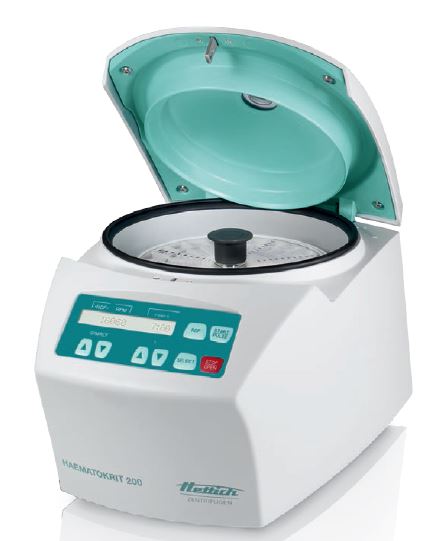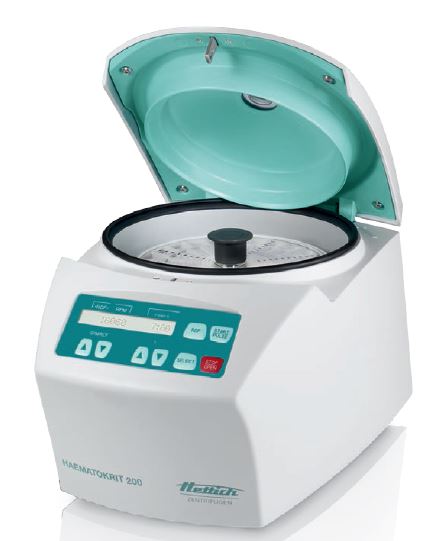CENTRIFUGE, haematocrit, electrical (Hettich Haematokrit200)
Valid Article
CENTRIFUGE, haematocrit, electrical
Definition
Rapid rotating system used to centrifuge haematocrit capillary tubes.
The model Haematokrit 200 replaces the Haematokrit 210.
Specifications
Quality standards
- EN IEC 61010-2-020, 2017, edition 3, Safety requirements for electrical equipment for measurement, control, and laboratory use - Part 2-020: Particular requirements for laboratory centrifuges
- EN 12547, 2014, Centrifuges - Common safety requirements
Technical specifications
- Fixed speed: ± 13,000 rpm
- Maximum RCF (Relative Centrifugal Force): 16,060 x g
- 1 to 99 minutes timer with 1 min intervals
- Haematocrit rotor for 24 capillary tubes of 75 mm
- Lid locking
- Power supply mains AC
- Voltage: 220 V, frequency 50-60 Hz
- Consumption: 250 VA
- Supplied with 2 spare fuses
Dimensions
- H x W x D: 247 x 275 x 330 mm
- Weight: approx. 10 kg
Instructions for use
Please consult the “Updated laboratory procedures, 2022” available online via the Laboratory working Group sharepoint page: Laboratory Procedures and Resources.
https://msfintl.sharepoint.com/sites/msfintlcommunities/LabWG/SitePages/Laboratory-Manual-page.aspx
For offline access, contact your laboratory advisor.
Precautions for Use
Secure all electrical devices in the laboratory with a UPS double conversion (see related articles below). To define the best sizing of the UPS, contact your biomedical or energy referent.
Maintenance
Carbons and fuses (ref: E997) must be replaced as required.
MSF requirements
Basic model.
Essential in a trypanosomiasis laboratory.
Can also be used for determining haematocrit in emergency and in surgical programmes.





![[ELABTUCA1H-] (centrifuge, haematocrit) TUBE, CAPILLARY, heparinized, 75mm](/web/image/product.template/571067/image_256/%5BELABTUCA1H-%5D%20%28centrifuge%2C%20haematocrit%29%20TUBE%2C%20CAPILLARY%2C%20heparinized%2C%2075mm?unique=1470ccf)
![[ELABTUCA1P-] (centrifuge, haematocrit) TUBE, CAPILLARY, plain, 75mm](/web/image/product.template/571058/image_256/%5BELABTUCA1P-%5D%20%28centrifuge%2C%20haematocrit%29%20TUBE%2C%20CAPILLARY%2C%20plain%2C%2075mm?unique=1470ccf)
![[ELAECEHA101] (centrifuge Haematokrit210/200) ROTOR 90° 24-place 2076](/web/image/product.template/574109/image_256/%5BELAECEHA101%5D%20%28centrifuge%20Haematokrit210-200%29%20ROTOR%2090%C2%B0%2024-place%202076?unique=a2afd95)
![[ELAECEHS101] (centrifuge Haematokrit210/200) FUSE T 3.15 AH/250V E997](/web/image/product.template/572069/image_256/%5BELAECEHS101%5D%20%28centrifuge%20Haematokrit210-200%29%20FUSE%20T%203.15%20AH-250V%20E997?unique=d761633)
![[ELAECEHS102] (centrifuge Haematokrit210/200) BUFFER TRAY E1400](/web/image/product.template/572251/image_256/%5BELAECEHS102%5D%20%28centrifuge%20Haematokrit210-200%29%20BUFFER%20TRAY%20E1400?unique=681371f)
![[ELAECEHS103] (centrifuge Haematokrit210/200) SEALING RING E4005](/web/image/product.template/572259/image_256/%5BELAECEHS103%5D%20%28centrifuge%20Haematokrit210-200%29%20SEALING%20RING%20E4005?unique=681371f)